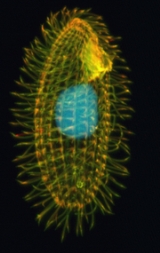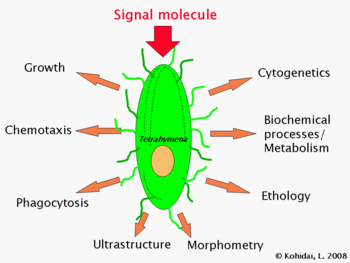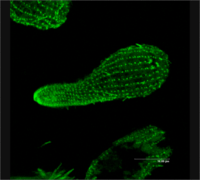
Tetrahymena
Encyclopedia
Tetrahymena are free-living ciliate
protozoa
that can also switch from commensalistic
to pathogenic modes of survival. They are common in fresh-water. Tetrahymena species used as model organisms in biomedical research are T. thermophila and T. pyriformis.

 As a ciliated protozoan, Tetrahymena thermophila exhibits striking nuclear dimorphism
As a ciliated protozoan, Tetrahymena thermophila exhibits striking nuclear dimorphism
: two types of cell nuclei, a large, somatic macronucleus
and a small, germline micronucleus
, exist in a single cell at the same time and carry out different functions with distinct cytological and biochemical properties. This unique versatility allows scientists to use Tetrahymena to identify several key factors regarding gene expression and genome integrity. In addition, Tetrahymena possesses hundreds of cilia and has complicated microtubule
structures, making it also an ideal model to elucidate the diversity and functions of microtubule systems.
Since Tetrahymena can be easily cultured in a large quantity in the laboratory, for years it has been a great source for biochemical analysis of important enzymatic activities and for purification of sub-cellular components. In addition, advanced molecular genetic techniques have been developed, including DNA-mediated transformation, gene 'knock-out' and 'knock-in' by homologous recombination
, epitope
tagging and inducible/repressible gene expression, making it an excellent model to study the gene function in vivo. Recently, the whole macronuclear genome
has been sequenced, which should promise Tetrahymena to be continuously utilized as a model system in the genomic and post-genomic era.
Tetrahymena thermophila occurs in 7 different variants (sexes) that can reproduce in 21 different combinations. A sex cannot reproduce sexually with itself.
Studies on Tetrahymena have contributed to several scientific milestones:
ISBN 0-12-544164-9
2. Collins, K. and Gorovsky, M.A. (2005). Tetrahymena thermophila Curr Biol. 15: R317-8.
3. Eisen JA, Coyne RS, Wu M, Wu D, Thiagarajan M, et al. (2006) Macronuclear Genome Sequence of the Ciliate Tetrahymena thermophila, a Model Eukaryote. PLoS Biol 4(9): e286
Microbial Digital Specimen Archives: Tetrahymena image gallery
Ciliate
The ciliates are a group of protozoans characterized by the presence of hair-like organelles called cilia, which are identical in structure to flagella but typically shorter and present in much larger numbers with a different undulating pattern than flagella...
protozoa
Protozoa
Protozoa are a diverse group of single-cells eukaryotic organisms, many of which are motile. Throughout history, protozoa have been defined as single-cell protists with animal-like behavior, e.g., movement...
that can also switch from commensalistic
Commensalism
In ecology, commensalism is a class of relationship between two organisms where one organism benefits but the other is neutral...
to pathogenic modes of survival. They are common in fresh-water. Tetrahymena species used as model organisms in biomedical research are T. thermophila and T. pyriformis.

T. thermophila: a model organism in experimental biology

Nuclear dimorphism
Nuclear dimorphism is a term referred to the special characteristic of having two different kinds of nuclei in a cell. This feature is observed in protozoa ciliates and some foraminifera. Ciliates contain two nucleus types: a macronucleus that is primarily used to control metabolism, and a...
: two types of cell nuclei, a large, somatic macronucleus
Macronucleus
A macronucleus is the larger type of nucleus in ciliates. Macronuclei are polyploid and undergo direct division without mitosis. It controls the non-reproductive cell functions, the everyday tasks, such as metabolism...
and a small, germline micronucleus
Micronucleus
A the micronucleus is the smaller nucleus in ciliate protozoans, such as the paramecium. In fission it divides by mitosis, and in conjugation furnishes the pairing of gamete nuclei, by whose reciprocal fusion a zygote nucleus is formed, which gives rise to the macronuclei and micronuclei of the...
, exist in a single cell at the same time and carry out different functions with distinct cytological and biochemical properties. This unique versatility allows scientists to use Tetrahymena to identify several key factors regarding gene expression and genome integrity. In addition, Tetrahymena possesses hundreds of cilia and has complicated microtubule
Microtubule
Microtubules are a component of the cytoskeleton. These rope-like polymers of tubulin can grow as long as 25 micrometers and are highly dynamic. The outer diameter of microtubule is about 25 nm. Microtubules are important for maintaining cell structure, providing platforms for intracellular...
structures, making it also an ideal model to elucidate the diversity and functions of microtubule systems.
Since Tetrahymena can be easily cultured in a large quantity in the laboratory, for years it has been a great source for biochemical analysis of important enzymatic activities and for purification of sub-cellular components. In addition, advanced molecular genetic techniques have been developed, including DNA-mediated transformation, gene 'knock-out' and 'knock-in' by homologous recombination
Homologous recombination
Homologous recombination is a type of genetic recombination in which nucleotide sequences are exchanged between two similar or identical molecules of DNA. It is most widely used by cells to accurately repair harmful breaks that occur on both strands of DNA, known as double-strand breaks...
, epitope
Epitope
An epitope, also known as antigenic determinant, is the part of an antigen that is recognized by the immune system, specifically by antibodies, B cells, or T cells. The part of an antibody that recognizes the epitope is called a paratope...
tagging and inducible/repressible gene expression, making it an excellent model to study the gene function in vivo. Recently, the whole macronuclear genome
Genome
In modern molecular biology and genetics, the genome is the entirety of an organism's hereditary information. It is encoded either in DNA or, for many types of virus, in RNA. The genome includes both the genes and the non-coding sequences of the DNA/RNA....
has been sequenced, which should promise Tetrahymena to be continuously utilized as a model system in the genomic and post-genomic era.
Tetrahymena thermophila occurs in 7 different variants (sexes) that can reproduce in 21 different combinations. A sex cannot reproduce sexually with itself.
Studies on Tetrahymena have contributed to several scientific milestones:
- First cell whose division was synchronized , leading to the first insights into the existence of cell cycleCell cycleThe cell cycle, or cell-division cycle, is the series of events that takes place in a cell leading to its division and duplication . In cells without a nucleus , the cell cycle occurs via a process termed binary fission...
control mechanisms. - Identification and purification of the first cytoskeletonCytoskeletonThe cytoskeleton is a cellular "scaffolding" or "skeleton" contained within a cell's cytoplasm and is made out of protein. The cytoskeleton is present in all cells; it was once thought to be unique to eukaryotes, but recent research has identified the prokaryotic cytoskeleton...
motor protein, i.e., dyneinDyneinDynein is a motor protein in cells which converts the chemical energy contained in ATP into the mechanical energy of movement. Dynein transports various cellular cargo by "walking" along cytoskeletal microtubules towards the minus-end of the microtubule, which is usually oriented towards the cell...
and determination of its directional activity. - Participation in the discovery of lysosomes and peroxisomes.
- One of earliest molecular descriptions of somatic genome rearrangement.
- Nobel-prize winning discovery (2009, in Physiology or Medicine) of the molecular structure of telomeres , telomeraseTelomeraseTelomerase is an enzyme that adds DNA sequence repeats to the 3' end of DNA strands in the telomere regions, which are found at the ends of eukaryotic chromosomes. This region of repeated nucleotide called telomeres contains non-coding DNA material and prevents constant loss of important DNA from...
enzyme , the templating role of telomerase RNA and their roles in cellular senescence and chromosome healing. - Nobel-prize winning co-discovery (1989, in Chemistry) of catalytic RNA (ribozyme).
- Discovery of the function of histoneHistoneIn biology, histones are highly alkaline proteins found in eukaryotic cell nuclei that package and order the DNA into structural units called nucleosomes. They are the chief protein components of chromatin, acting as spools around which DNA winds, and play a role in gene regulation...
acetylationAcetylationAcetylation describes a reaction that introduces an acetyl functional group into a chemical compound...
. - Discovery of the roles of RNA interferenceRNA interferenceRNA interference is a process within living cells that moderates the activity of their genes. Historically, it was known by other names, including co-suppression, post transcriptional gene silencing , and quelling. Only after these apparently unrelated processes were fully understood did it become...
-like pathway in the heterochromatinHeterochromatinHeterochromatin is a tightly packed form of DNA, which comes in different varieties. These varieties lie on a continuum between the two extremes of constitutive and facultative heterochromatin...
formation - Demonstration of the physiological roles of the posttranslational modificationPosttranslational modificationPosttranslational modification is the chemical modification of a protein after its translation. It is one of the later steps in protein biosynthesis, and thus gene expression, for many proteins....
(i.e. acetylation and glycylation) on tubulins and identification of the enzymes responsible for some of these modifications (glutamylation) - Crystal structure of 40S ribosome in complex with initiation factor eIF1
Further reading
1. Methods in Cell Biology Volume 62: Tetrahymena thermophila, Edited by David J. Asai and James D. Forney. (2000). By Academic PressISBN 0-12-544164-9
2. Collins, K. and Gorovsky, M.A. (2005). Tetrahymena thermophila Curr Biol. 15: R317-8.
3. Eisen JA, Coyne RS, Wu M, Wu D, Thiagarajan M, et al. (2006) Macronuclear Genome Sequence of the Ciliate Tetrahymena thermophila, a Model Eukaryote. PLoS Biol 4(9): e286
External links
- Tetrahymena Genome Database
- Tetrahymena thermophila Genome Project at The Institute for Genomic ResearchThe Institute for Genomic ResearchThe Institute for Genomic Research was a non-profit genomics research institute founded in 1992 by Craig Venter in Rockville, Maryland, United States. It is now a part of the J. Craig Venter Institute.-History:...
- Tetrahymena thermophila Genome Sequence Synopsis
- Tetrahymena thermophila genome paper
Microbial Digital Specimen Archives: Tetrahymena image gallery

